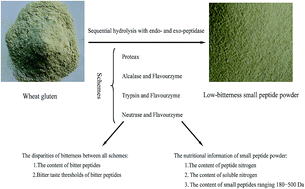Effect of sequential hydrolysis with endo- and exo-peptidase on bitterness properties of wheat gluten hydrolysates
Abstract
After the bitterness of wheat gluten (WG) hydrolysates using single-enzyme treatment was assessed by taste dilution analysis (TDA), schemes of sequential hydrolysis with endo- and exo- peptidases were designed to prepare low-bitterness small-peptide powders. This study is the first to attempt the enrichment of the low-bitterness small peptide and search for explanations for the disparity of the bitterness between the schemes. The effects of the peptide nitrogen content, amino acid composition, molecular weight distribution and amino acid sequence on the sensory characterization and sensor response of the electronic tongue in WG hydrolysates are discussed. The results showed the disparity of the bitterness between all schemes was determined by the bitter taste thresholds of bitter peptides, but not the content of bitter peptides. Bitter taste thresholds were affected by the amino acid sequences and molecular weights of the bitter peptides. It was found that when WG was hydrolysed for 300 min by Proteax, the hydrolysates exhibited the lowest bitterness while they had the highest content of small peptides ranging from 180–500 Da.


 Please wait while we load your content...
Please wait while we load your content...